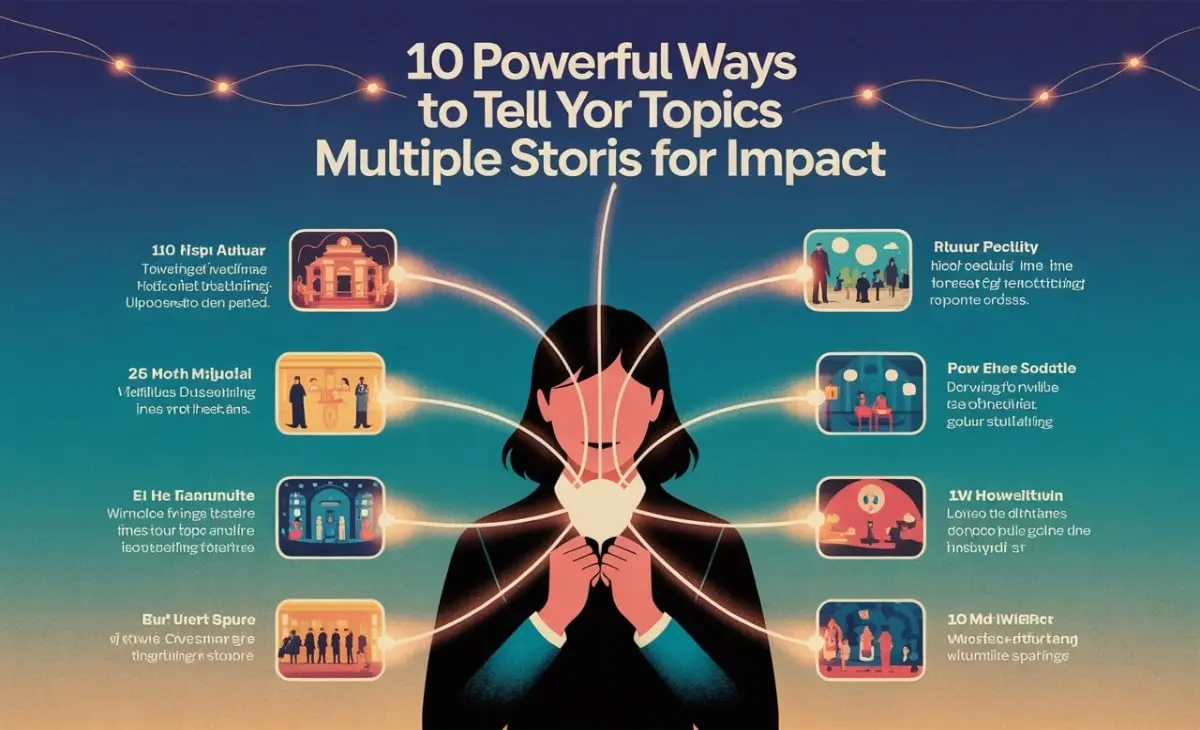In the modern content landscape, one-dimensional storytelling no longer creates the emotional pull or intellectual trust audiences seek. To truly resonate, you need to tell your topics multiple stories. This means unpacking your topic in a variety of ways, allowing it to connect across different emotional tones, formats, and audience needs.
The power of storytelling lies in perspective—and when you offer more than one, your message becomes layered, memorable, and impactful, often rooted in digital identity and layered meaning. This guide explores how you can master the art of story multiplicity for any topic, using proven structures, formats, and persona-driven strategies.
Understanding Your Topic’s Multiple Stories
The idea behind telling multiple stories around a single topic is to go beyond the surface. Rather than providing a single explanation, you explore the same theme through different lenses. This allows your message to be felt, not just heard. Story diversity builds emotional depth, broadens your audience appeal, and clarifies complexity.
For example, consider your topics multiple stories of sustainable living. One story could be an emotional testimony from someone who reduced their carbon footprint. Another could be a research-based breakdown of climate impact. A third might involve a practical how-to guide for building a zero-waste kitchen. Together, these stories offer a richer, more complete view.
Why One Story Is Never Enough
A single narrative often limits your audience engagement. Different individuals respond to different storytelling styles. By providing multiple stories, you’re addressing the wide spectrum of learning styles, cognitive preferences, and emotional triggers that make up your audience.
Additionally, stories told from various angles reinforce the central message. One might create emotional resonance, another might validate with logic, and a third might provide actionable steps. The audience doesn’t just consume your content—they relate to it.
Benefits of Story Multiplicity Across Content Types
- Blogs: Multiple stories within a blog can be segmented into reader-specific sections, offering both technical and emotional insights.
- Podcasts: Episodes can be dedicated to different experiences related to the same theme, such as expert interviews vs. user stories.
- Courses: Lessons can include various narratives to demonstrate the practical application of theory, making content more relatable and retainable.
Each format is an opportunity to reinforce your message while reaching different audience types.
Common Mistakes in Telling Multiple Stories
Many content creators mistakenly think that telling different stories means repeating the same point in a different tone. That’s not true multiplicity. A common pitfall is the lack of thematic cohesion. When stories are not tied to a central message or are placed without context, they confuse rather than clarify. Additionally, the overuse of similar tones or emotional triggers can make multiple stories feel redundant rather than refreshing. The key is intentional diversity—stories should vary in purpose, style, and structure but still connect to the same core idea.
The Audience Matrix: Who Needs Which Story?
Not all stories work for all people. Your audience is diverse, so your stories should reflect that . Some people want data; others need emotional motivation. Understanding your audience is crucial. For example, analytical thinkers will resonate with statistics and case studies, while emotional thinkers seek vulnerability and relatability. Practical users prefer how-to guidance, while visionaries want aspirational storytelling. Mapping your personas to preferred storytelling styles ensures each group finds value in your content.
Step-by-Step Framework: Crafting Your Topic’s Multiple Stories
The process of developing your topics multiple stories for one topic starts with identifying the core message. What is the single most important thing your audience needs to understand? From there, consider five distinct storytelling lenses: emotional, logical, aspirational, instructive, and community-driven. Each lens offers a different experience.
Choose a proven storytelling structure for each lens. The Hero’s Journey is ideal for personal transformation. Before-After-Bridge helps illustrate change. Problem-Agitate-Solution works well for urgency-driven narratives. Assign the best format—whether blog, video, podcast, or infographic—based on the story’s emotional tone and the platform you plan to use.
Lastly, make sure each story returns to your core theme. The story should not be a standalone anecdote but part of a larger message puzzle that helps your audience piece together more profound understanding.
Real-World Example: One Topic, Three Stories
Let’s say your topic is remote team management. You can tell three very different stories to support it.
- One story could follow the emotional arc of a struggling team leader who found success using asynchronous tools.
- A second story might present hard data showing the rise in productivity among distributed teams.
- A third could be a how-to guide on implementing Slack protocols for better communication.
Each story has a unique tone and purpose, but all reinforce the core concept: remote teams can thrive with the right systems in place.
The best platforms for multi-story storytelling.
When sharing multiple stories, the platform you choose affects how your narrative is perceived. For professional insights, LinkedIn works well—allowing room for in-depth storytelling that includes both personal wins and industry case studies. Instagram, by contrast, leans into quick visual storytelling, suitable for behind-the-scenes snippets or customer journeys.
YouTube is perfect for long-form video storytelling—such as mini-docs or vlogs—while email offers a serialized, intimate form of storytelling ideal for nurturing trust over time. Podcasts create space for deeper reflection, expert conversations, and storytelling in a conversational tone. Each platform allows your message to breathe differently.
Content Repurposing: One Story, Many Formats
- A single blog post about overcoming burnout can be transformed into a Twitter thread sharing key tips, a YouTube video for context, and an infographic summarizing the process.
- A podcast conversation can become a blog with pull quotes, an email summary, and carousel slides for Instagram.
- A client success story can evolve into a testimonial page, a case study document, and a speaking point in your next webinar.
The key is to extract different assets from one narrative and distribute them strategically across formats. Repurposing ensures each version serves a unique audience or stage in the user journey.
Measuring the Impact of Multi-Angle Storytelling
To evaluate the effectiveness of telling your topics multiple stories, look beyond traditional metrics like clicks or views. Track engagement rate, time spent on page, content completion, and social shares. Comments and feedback offer qualitative conclusions about which story resonated most.
Analyze patterns: are emotional stories driving more shares while technical stories boost SEO? Is your video content getting longer retention times than text-based blogs? This kind of analysis helps you refine not only your messaging but also your format and channel selection.
SEO Strategy for Your Topics Multiple Stories
Search engines reward structured, valuable, and semantically rich content. Each story type allows you to naturally include different keywords related to your core topic. An emotional story might contain user intent terms like “how I overcame,” while a technical post includes keywords like “statistics on” or “research shows.”
Make use of heading tags to separate story types, include internal links between related content pieces, and add alt text to images with the focus keyword. Avoid keyword stuffing. Let variety in storytelling organically increase your search footprint.
FAQs
What are multiple stories around a topic?
They are different narratives—emotional, technical, aspirational, practical—built around the same core subject to create a richer and more relatable message.
Why is multi-story content effective?
Different people connect with different types of stories. It improves engagement, trust, and learning retention by catering to varied emotional and cognitive styles.
How do I avoid repetitive storytelling?
Use distinct structures, vary emotional tones, and align each story with a different audience persona or intent. Furthermore, diversify your formats and storytelling frameworks.
Can I reuse a story on different platforms?
Absolutely. You can and should repurpose stories across platforms in unique formats—just adjust tone, length, and structure to fit the medium and audience.
Which story formats work best for professional audiences?
Case studies, interviews, and data-backed insights are highly effective for professionals. Use LinkedIn, blogs, and whitepapers for formal storytelling.
What’s a good tool for managing story planning?
Tools like Notion, Trello, or Airtable help you storyboard and plan your content calendar. You can organize by persona, platform, story type, or campaign goal.
Final Thoughts
Crafting your topics multiple stories isn’t just a content strategy—it’s an empathy practice. Each narrative you create allows your audience to see your topic from a new angle. This builds trust, credibility, and connection. The more versatile your stories, the deeper your impact.
Now’s your moment to shift from telling people what you know to showing them why it matters—again and again, in the ways they understand best.





